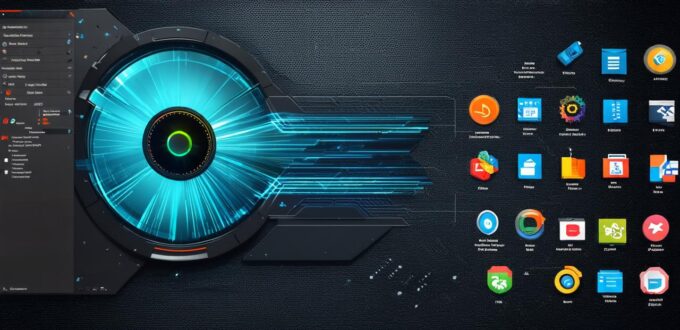Introduction
Computer software refers to the set of instructions and programs that enable computers to perform specific tasks. These instructions are written in a programming language, which is then compiled into machine-readable code. The software can range from simple applications like web browsers and video players to complex systems used by businesses and governments.
In this guide, we will explore the various components of computer software and their functions. We will also discuss some of the best practices for developing software, as well as the challenges that developers face. By the end of this guide, you should have a better understanding of what is included in computer software and how to create effective programs.
1. Hardware Components
Before we dive into the various components of software, it’s important to understand the hardware components that enable computers to run software. These include:
- Central Processing Unit (CPU): The CPU is the brain of the computer. It processes data and executes instructions.
- Random Access Memory (RAM): RAM is the temporary storage used by the CPU for processing data. It determines the speed at which a computer can perform tasks.
- Storage Devices: These include hard drives, solid-state drives, and other storage devices that store data permanently.
- Input/Output Devices: These include keyboards, mice, monitors, and other devices used to interact with the computer.
2. Operating Systems
An operating system (OS) is the software that manages the hardware components of a computer. It provides a user interface for the user to interact with the computer, as well as various services that enable applications to run. Some popular operating systems include Windows, macOS, and Linux.
3. Programming Languages
Programming languages are used to write instructions for computers to execute. These languages include:
- C++: A general-purpose programming language that is widely used in the development of software applications, games, and operating systems.
- Java: A popular programming language used for developing applications across a wide range of platforms.
- Python: A high-level programming language that is easy to learn and use, making it a popular choice for beginners.
4. Software Development Life Cycle (SDLC)
The SDLC is the process that developers follow when creating software programs. It includes several stages, including:
- Requirements Gathering: This involves identifying the needs of the end-user and creating a detailed plan for the software program.
- Design: In this stage, developers create a blueprint for the software program, detailing its architecture and design.
- Development: This involves writing code, testing, and debugging the program.
- Testing: This stage involves finding and fixing bugs in the program.
- Deployment: Once the program has been tested and approved, it is deployed to production.
- Maintenance: This stage involves updating and maintaining the software program to ensure that it continues to meet the needs of users.
5. Best Practices for Developing Software
There are several best practices that developers should follow when creating software programs. These include:
- Modularity: Writing modular code that can be easily reused and modified makes it easier to maintain the software program over time.
- Documentation: Documenting code and processes helps other developers understand how the software works, making it easier to maintain and update.
- Testing: Thoroughly testing the software program before deployment ensures that it is stable and reliable.
- Security: Developers should prioritize security by incorporating measures to protect against common attacks such as viruses and malware.
6. Challenges in Software Development
Developing software can be challenging due to several factors, including:
- Complexity: The complexity of the software program can make it difficult to develop and maintain.
- Cost: Developing software can be expensive, especially for small businesses or startups.
- Time: Developing software can take a long time, especially for complex programs that require extensive testing and debugging.

7. Case Studies
To illustrate the various components of computer software, let’s examine two case studies:
Case Study 1: Developing a Mobile App
A mobile app developer creates a new app for a local coffee shop. The app allows users to order food and drinks, track their orders, and pay online. To create this app, the developer must consider the following components:
- Hardware Components: The app will run on smartphones, which require specific hardware configurations such as processing power, RAM, and storage space.
- Operating Systems: The app must be compatible with multiple operating systems, including iOS and Android.
- Programming Languages: The developer uses Swift for the iOS version of the app and Java for the Android version.
- SDLC: The developer follows the SDLC to ensure that the app is thoroughly tested and debugged before launch.
- Best Practices: The developer incorporates best practices such as modular code and documentation to make the app easier to maintain over time.
- Challenges: The developer faces challenges such as compatibility issues with different smartphone models and operating systems, as well as the need for extensive testing to ensure that the app is stable and reliable.
Case Study 2: Developing an Enterprise Software System
An enterprise software system is a complex program used by businesses to manage their operations. A software development team creates an enterprise resource planning (ERP) system for a manufacturing company. The ERP system manages inventory, production, and finance. To create this system, the team must consider the following components:
- Hardware Components: The ERP system will run on servers with high processing power and RAM to handle large amounts of data.
- Operating Systems: The system must be compatible with multiple operating systems used by employees across different locations.
- Programming Languages: The team uses Java for the backend and JavaScript for the frontend.
- SDLC: The team follows the SDLC to ensure that the system is thoroughly tested and debugged before launch.
- Best Practices: The team incorporates best practices such as modular code, documentation, and version control to make the system easier to maintain over time.
- Challenges: The team faces challenges such as integration with existing systems, data security, and training employees on how to use the new ERP system.
Summary
Computer software is a complex system that involves various components, including hardware, operating systems, programming languages, and development processes. Developers must consider these components when creating software programs, whether it’s a mobile app or an enterprise resource planning system. By following best practices and addressing challenges, developers can create effective and reliable software programs that meet the needs of users.
FAQs
Here are some frequently asked questions about computer software:
- What is computer software?
- What are some popular programming languages used for developing software?
- What is the SDLC?
- What are some best practices for developing software?
- What are some challenges faced by developers when creating software programs?
Computer software refers to the set of instructions and programs that enable computers to perform specific tasks. These instructions are written in a programming language and compiled into machine-readable code.
Some popular programming languages include C++, Java, Python, and JavaScript.
The Software Development Life Cycle (SDLC) is a process that developers follow to ensure that software programs are thoroughly tested and debugged before deployment. The SDLC includes stages such as design, development, testing, deployment, and maintenance.
Best practices include modular code, documentation, version control, and thorough testing.
Developing software can be challenging due to several factors, including complexity, cost, time, compatibility issues, data security, and training employees on how to use new systems.
